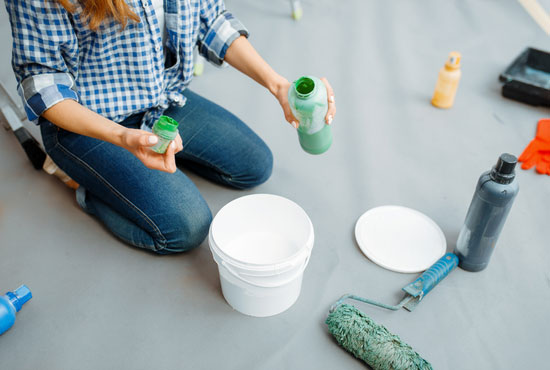Whenever you want a high sheen on the item you are painting you want to use oil-based paint. They are durable, can withstand the outdoor elements, are protective, and are simply beautiful. Since we are dedicated to providing accurate information on everything paint-related, we knew we had to answer the question of how to thin oil-based paint.
When we talked to the painting professionals, we specifically asked them how to thin oil-based paint for the spray guns. Spray guns have become staples in most home tool sheds so we wanted our homeowners to know how to thin the paint so it flows properly from their sprayer, and they do not end up with waste material that is useless.
We decided to start with the basics about these paint substances and then venture into how to do the thinning and more.
What Is Oil-Based Paint?

In oil-based paints, natural oils such as linseed oil, or synthetic alkyd are combined with a pigment or color and a resin. The thinner or linseed oil will evaporate as the paint dries on the surface so a hard coating is left where you applied the paint.
Oil-based paints create durable and beautiful finishes. If you are painting something that you do not want to have to paint often, and you want a hard finish, then choose the oil-based products.
These paints have a higher gloss so they reflect light better. They can make an imperfect surface look perfect with this light refraction. The sheen of the paint will dull over time and after a few, the sheen will be no greater than the sheen of water-based paint. But, for those few years, you have had remarkable shine.
If you are painting something metal, and you want to keep rust and corrosion at bay, then choosing an oil-based paint is your best option. The coating that these paints create does not breathe and does not allow humidity or water to penetrate it. You get a new look and a protective barrier that protects the metal.
Why You Have to Thin the Paint?

Normally if you are applying oil-based paints with a brush or roller you really do not have to thin the substance. A brush or roller can handle the thickness of the paint and what you have to correct is your application technique.
If you are using a paint sprayer then you have usually got to thin this paint because it is simply too thick to flow properly through the gun and float in tiny droplets to the surface material you are painting.
Thinning the paint makes it easier to spread the substance in an even coating that will dry properly and create the protective barrier that you desire.
Read More>> Paint A Bathtub How To Easily & Inexpensively
Use the Right Pieces of Stuff for Thinning Oil-Based Paint
When you are thinning oil-based paints you need to use the right substances. If you use the wrong substance then they either will not mix in with the paint or they will break down the paint and create a mess.
The right things to use are:
- Commercial paint thinners
- Mineral spirits
- Turpentine
- Linseed oil
What Not to Use:
- Water
- Cooking oils
- Acetone
- Paint removers
Guide to Thin Oil-Based Paints in 7 Steps

Step 1: Gather your supplies:
- Paint
- Thinning agent of choice, turpentine or mineral spirits will work dandy
- Stir sticks
- A clean bucket
- Dry cloths for wiping up spills
- Dry paint brush
- Measuring cup
- Plastic gloves
- Eye protection like goggles
You are going to want to thin your paint in a 4-to-one ratio.
Step 2: Pour a measured amount of paint into the clean bucket
Step 3: Pour one measure of paint thinner into the paint. If you used 4 cups of paint then you will use one cup of thinner as your base ratio.
Step 4: Stir the two substances together. Stir slowly in circular motions and after a period of time make your circles in the opposite direction. If you try to stir these substances too quickly you will not get a uniform mixture and you will risk splashing the paint and thinner onto yourself.
Step 5: Check the consistency of the paint by dipping your paint brush into it and painting a small area on some cardboard or another surface. You want the material to cover thickly and consistently. It should not be hard to get a transfer from your brush to the surface. If you have to mash down on the brush then the paint is still too thick. If the paint runs or drips easily then the paint is too thin. If the paint is too thick or thin you need to make adjustments and then try the brush on test again. Here is an article on how to paint a door without brush marks
Step 6: You are ready to spray the surface and create a new look on your item. You have to remember that oil-based paints dry slower than water-based ones so be patient and let each coat dry completely before you attempt to apply another layer. Sometimes it can take as long as 24 hours for certain oil-based materials to cure properly.
Step 7: Clean your spray gun using the mineral spirits or turpentine like you used to thin the paint. You have to clean the paint out of the spray equipment with a solvent that can break the paint up and make it go away.
Acetone does dissolve paint and can even dissolve have dried on paint. Be careful putting acetone into your sprayer during cleaning because it can also damage plastic components in the tool and cause serious damage.
After you clean your gun with mineral spirits or turpentine you are then going to want to clean it again using warm soapy water. The warm soapy water will remove the residue left behind from the mineral spirits and turpentine. It will stop those substances from making a lingering odor or presence on your equipment.
How to Thin Oil-Based Paints for Spray Gun

If you plan to use oil-based paints in a spray gun the following steps are the general guidelines for thinning these paints.
Materials you should have
- Oil-based paint
- Clean bucket or container for mixing purposes
- Paint stirring sticks to stir the thinner into the paint
- Paint strainers to strain out any clumps, lumps, or debris
- A funnel
- Measuring cup
- Turpentine or mineral spirits, or some other thinning solvent approved for oil-based paints
- A viscosity cup (you probably have one with your paint sprayer)
- Spray gun
- Tip for the spray gun
- Eye protection like goggles
- Face mask and disposable gloves
Step 1: Mix the paint and thinner in the clean bucket. Use the four-to-one ratio to start with, and you can thin more later if the substance does not work properly in your paint gun. Your spray gun more than likely came with a recommended thinning ratio for different paints.
Be sure to check the manual and see what ratio the manufacturer recommended for your equipment. Be patient because it can take several minutes to get these two substances mixed properly.
Step 2: Pour the paint into a viscosity cup and into your material cup on your painter. If you do not have a viscosity cup just pour the thinned material directly into the material cup on your sprayer.
Step 3: Spray some of the paint onto a piece of cardboard. You are checking to ascertain whether the paint is the right consistency. If the paint comes out it spatters and leaves areas that are not covered you may have to get a larger tip or thin the paint down some more.
If you see runs or drips then you have likely added too much thinner to the paint. You need to pour the paint back into the bucket, add more paint, and then stir it completely. Once it is stirred completely put it back into the material cup of the sprayer and do another test spray.
Read More>> How Long Does It Take Spray Paint to Dry?
Frequently Asked Question
What can be used to thin oil paint?
Turpentine and mineral spirits are two of the most common dilution materials used for these paints. They are inexpensive and can be purchased at most paint supply centers and hardware stores.
Can I use vegetable oil to thin oil paint?
Vegetable oil and olive oil are non-drying oils that do not effectively thin paint. You can use linseed oil to thin paint but do not use vegetable oil
Can you thin oil paint with baby oil?
Baby oil can be used to condition your paintbrushes, and it can be used to stop paint from adhering to your paint tray. Do NOT try to thin your paint using baby oil.
What is the ratio of paint to thinner for a spray gun?
Normally you use one part thinning agent to three parts paint. This thins the material by about 10%.
Final Thoughts
Thinning oil-based paints before using them in a spray gun is common. There are, however, a lot of newer spray guns that can handle the thickness of these paints without any thinning being required. If you plan to use oil-based paints or latex paints often around your home it will behoove you to look for equipment that can spray the thicker paints without thinning them down.
By spraying the paint without thinning it you can create a thicker covering that is faster to complete. When you thin the paint, you need more coats for the item to be properly covered, but the thinner coats dry faster, so the application time is not really increased by much.
